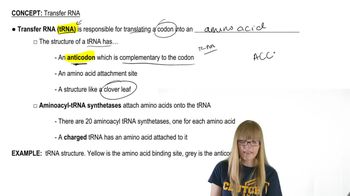Table of contents
- 1. Introduction to Genetics51m
- 2. Mendel's Laws of Inheritance3h 37m
- 3. Extensions to Mendelian Inheritance2h 41m
- 4. Genetic Mapping and Linkage2h 28m
- 5. Genetics of Bacteria and Viruses1h 21m
- 6. Chromosomal Variation1h 48m
- 7. DNA and Chromosome Structure56m
- 8. DNA Replication1h 10m
- 9. Mitosis and Meiosis1h 34m
- 10. Transcription1h 0m
- 11. Translation58m
- 12. Gene Regulation in Prokaryotes1h 19m
- 13. Gene Regulation in Eukaryotes44m
- 14. Genetic Control of Development44m
- 15. Genomes and Genomics1h 50m
- 16. Transposable Elements47m
- 17. Mutation, Repair, and Recombination1h 6m
- 18. Molecular Genetic Tools19m
- 19. Cancer Genetics29m
- 20. Quantitative Genetics1h 26m
- 21. Population Genetics50m
- 22. Evolutionary Genetics29m
17. Mutation, Repair, and Recombination
Types of Mutations
Problem 37b
Textbook Question
Textbook QuestionInfantile cardiomyopathy is a devastating disorder that is fatal during the first year of life due to defects in the function of heart muscles resulting from mitochondrial dysfunction. A study, performed by Götz et al. [(2011). Am. J. Hum. Genet. 88:635–642), identified two different causative mutations in the gene for mitochondrial alanyl-tRNA synthetase (mtAlaRS). One mutation changes a leucine residue at amino acid position 155 to arginine (p.Leu155Arg). The other mutation changes arginine at position 592 to tryptophan (p.Arg592Trp). The mtAlaRS enzyme has an N-terminal domain (amino acids 36–481) that catalyzes tRNA aminoacylation and an internal editing domain (amino acids 484–782) that catalyzes deacylation in the case that the tRNA is charged with the wrong amino acid.
Which mutation would you predict has a more severe impairment of translation in mitochondria, and why?
 Verified Solution
Verified SolutionThis video solution was recommended by our tutors as helpful for the problem above
Video duration:
1mPlay a video:
Was this helpful?
Key Concepts
Here are the essential concepts you must grasp in order to answer the question correctly.
Mitochondrial Function and Translation
Mitochondria are essential organelles responsible for energy production and play a critical role in protein synthesis. They have their own genetic material and machinery for translating mitochondrial genes. The process of translation in mitochondria involves the charging of tRNA with specific amino acids, which is crucial for synthesizing mitochondrial proteins. Any dysfunction in this process can lead to severe cellular consequences, particularly in energy-demanding tissues like the heart.
Recommended video:
Guided course

Functional Genomics
Aminoacyl-tRNA Synthetase (AARS) Function
Aminoacyl-tRNA synthetases are enzymes that attach the correct amino acid to its corresponding tRNA, a process vital for accurate protein synthesis. The mtAlaRS specifically charges tRNA with alanine, ensuring that proteins are synthesized correctly in mitochondria. Mutations in the mtAlaRS can lead to mischarging of tRNA, resulting in the incorporation of incorrect amino acids into proteins, which can severely impair mitochondrial function and lead to diseases like cardiomyopathy.
Recommended video:
Impact of Specific Mutations on Protein Function
Mutations in genes can lead to changes in the amino acid sequence of proteins, potentially altering their structure and function. The severity of the impact often depends on the location and nature of the mutation. For instance, a mutation that changes a critical residue involved in the enzyme's active site or structural integrity may lead to a more significant loss of function compared to a mutation in a less critical region. Understanding the specific changes caused by mutations in mtAlaRS is essential for predicting their effects on mitochondrial translation.
Recommended video:
Guided course

Proteins

 9:49m
9:49mWatch next
Master Point Mutations with a bite sized video explanation from Kylia Goodner
Start learning




